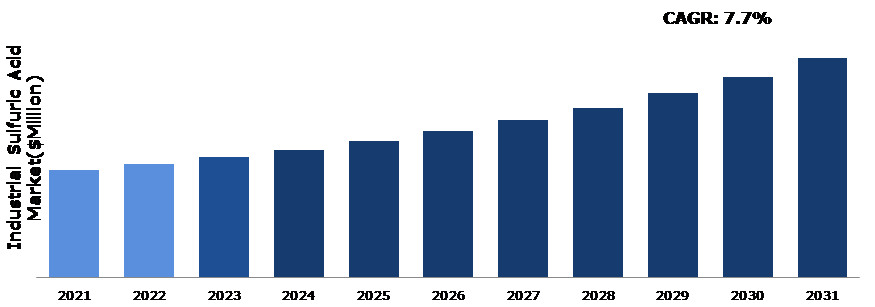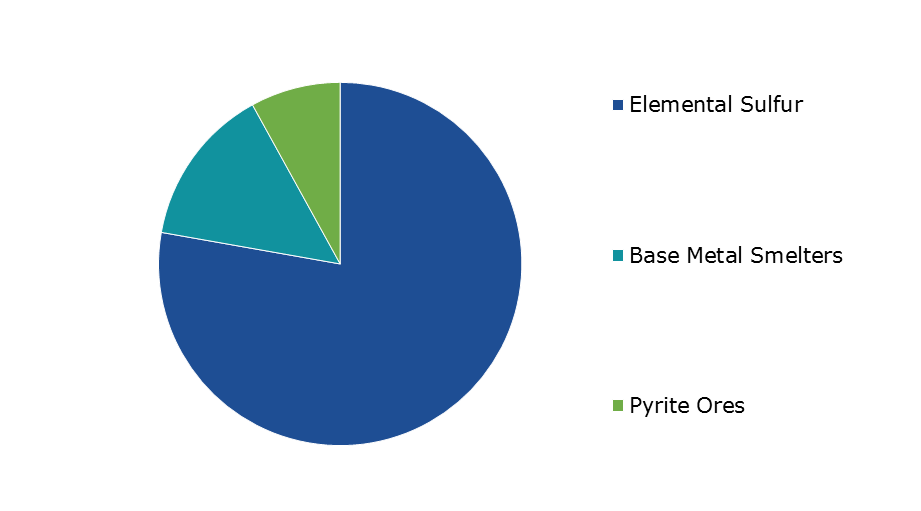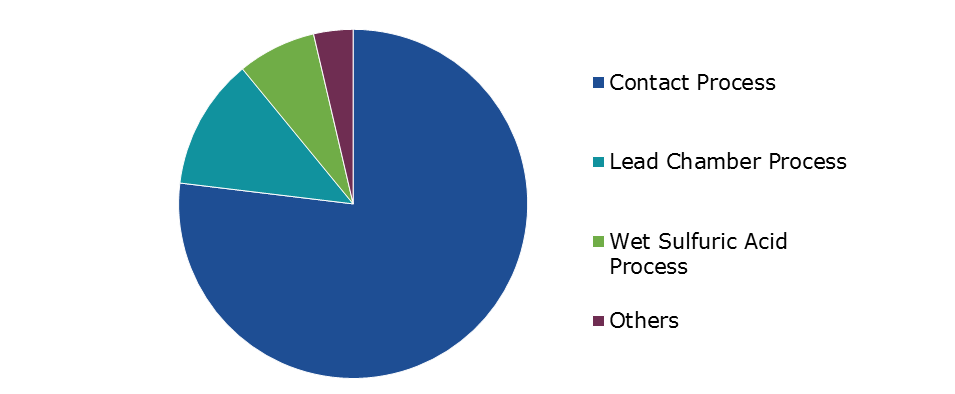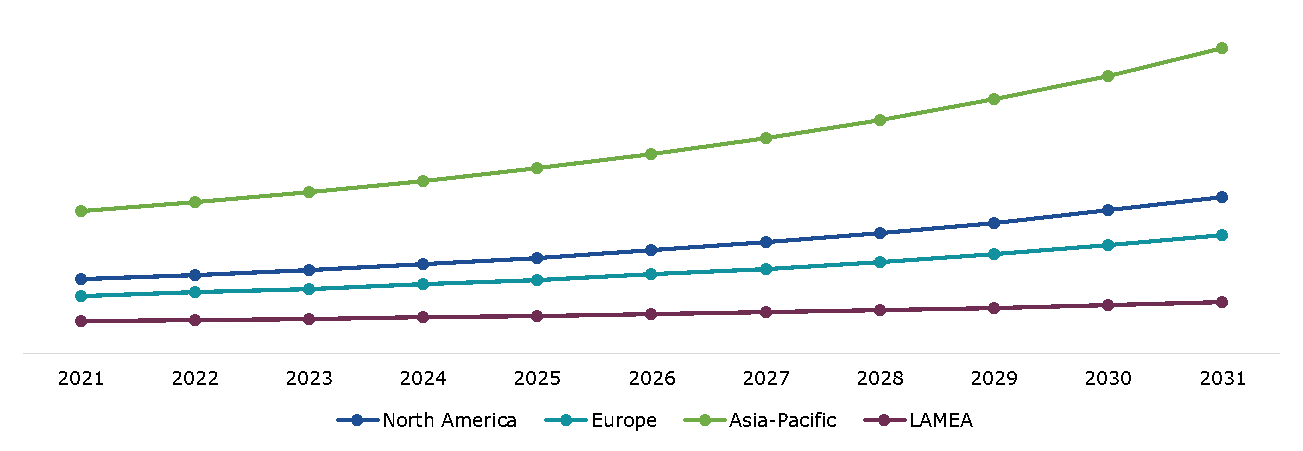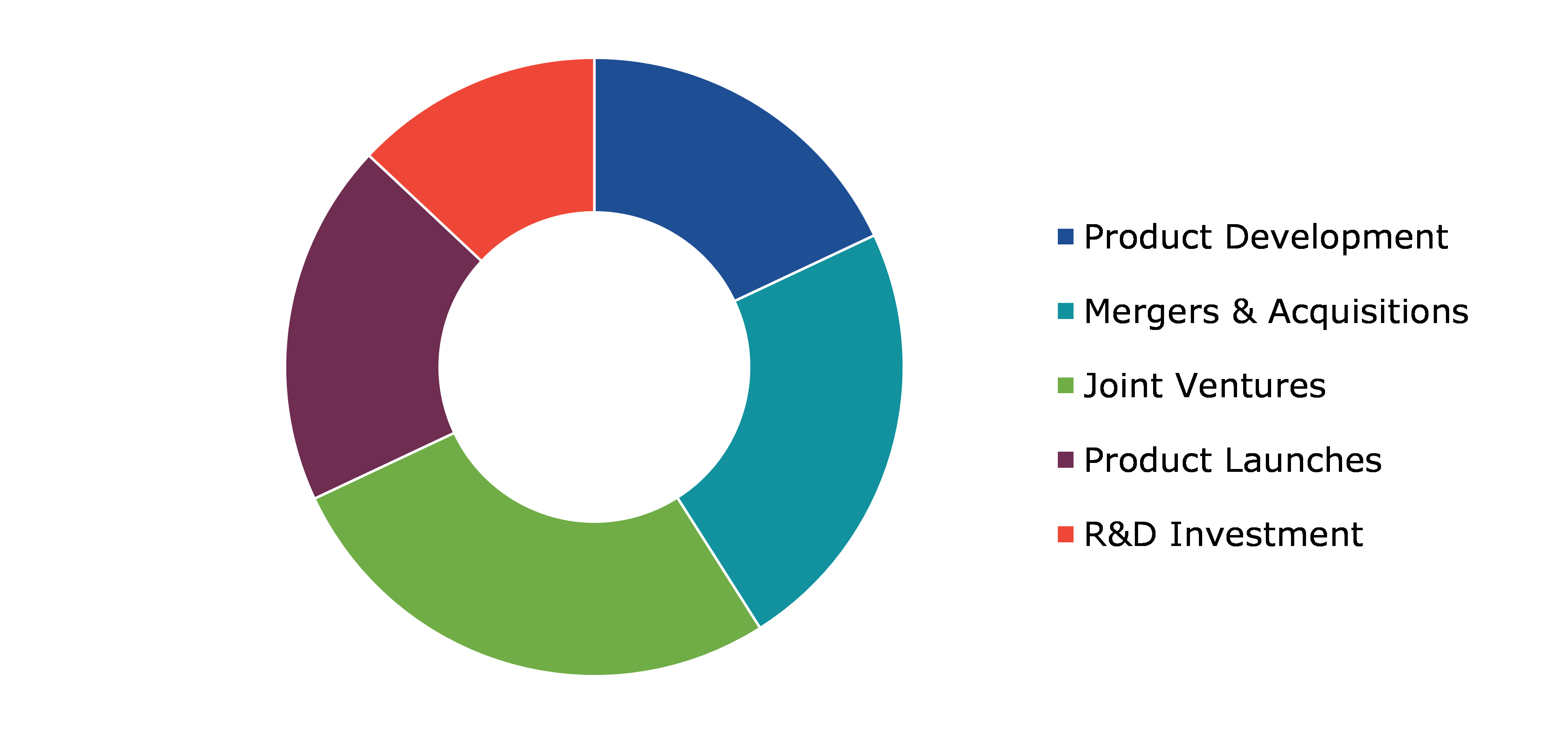Industrial Sulfuric Acid Market Report
RA08679
Industrial Sulfuric Acid Market by Raw Materials (Elemental Sulfur, Base Metal Smelters, and Pyrite Ores), Manufacturing Process (Contact Process, Lead Chamber Process, Wet Sulfuric Acid Process, and Others), and Regional Analysis (North America, Europe, Asia-Pacific, and LAMEA): Global Opportunity Analysis and Industry Forecast, 2022-2031
Global Industrial Sulfuric Acid Market Analysis
The Global Industrial Sulfuric Acid Market Size was $4,662.0 million in 2021 and is predicted to grow with a CAGR of 7.7%, by generating a revenue of $9,576.5 million by 2031.
Global Industrial Sulfuric Acid Market Synopsis
The adoption of industrial sulfuric acid in a variety of industries, including fertilizers, chemicals, and automobile manufacturing, is a major market driver. Industry share of gas-based elemental sulfur is expected to witness significant momentum on account of their its. The growing emphasis on the critical role of elemental sulfur solubility on sour gas reservoir development will also contribute to the industry expansion. The rising number of research activities is another impact rendering factor for product consumption. The increasing count of natural gas reservoirs for extracting sulfur will also aid in the market development. Sulfuric acid is a fluid material that is readily soluble, colorless, and odorless and is miscible with water. This factor is estimated to drive the market growth during the forecast period.
Sulfuric acid is made from sulfur dioxide, which is released through the combustion of coal, oil, and gas. Sulphur dioxide is progressively converted to sulfur trioxide, which reacts with water vapor in the air to produce sulfuric acid. Sulfuric acid may float in the air for varying periods of time. Sulfuric acid in the rain contributes to acid rain. Acid rain endangers both human health and the ecosystem. Forests and wildlife may sustain significant harm. As a consequence of it seeping into the ground, nutrients such as calcium and magnesium that are required for the growth and development of trees and other natural flora are dissolved. As a result, the adverse effects of sulfuric acid are expected to limit the sulfuric acid demand. The loss of arable land brought on by rapid urbanization and industrialization is forcing farmers to use fertilizers to boost crop yield. The increasing use of H2SO4 in the manufacture of high-quality agricultural fertilizers to increase production capacity is anticipated to fuel market growth. The majority of the production of tainted sulfuric acid, which leads to the regeneration of pure and concentrated H2SO4 products, occurs in chemical and petroleum refineries. Low emissions from the regenerated acids result in lower production costs, making it sustainable and environmentally friendly. Over the course of the forecast period, rising investments in chemical synthesis research and development in China's chemical manufacturing industry are anticipated to drive excellent opportunity for the market expansion.
According to regional analysis, Asia-Pacific region is expected to continue to be a significant growth factor for the industrial sulfuric acid market in the coming years, driven by increasing demand for fertilizers, industrialization and infrastructure development, and government initiatives promoting sustainable technologies.
Industrial Sulfuric Acid Overview
Sulfuric acid is a colorless, odorless, and viscous liquid soluble in water at all concentrations. It is a strong acid made by oxidizing sulfur dioxide solutions and used in large quantities as an industrial and laboratory reagent. The growing demand for sulfuric acid is due to its increased utilization in the agriculture and automotive sectors. Sulfuric acid is widely used due to its direct and indirect applications in manufacturing many chemicals, including fertilizers. The Asia-Pacific region is the largest consumer of fertilizers due to the increased demand for sulfuric acid-based fertilizers in the region.
COVID-19 Impact on Global Industrial Sulfuric Acid Market
The sulfuric acid sector has suffered as a result of the COVID-19 pandemic. The pandemic decreased the demand for various goods and services, disrupted global supply lines, and decreased industrial production, all of which had a negative impact on economic development. The need for sulfuric acid has decreased in important industries including oil and gas, mining, and industrial production. Lockdowns associated with the pandemic and decreased consumer demand caused many companies to face a fall in production, which in turn lowered the need for sulfuric acid. In addition, the pandemic affected the availability of chemicals and raw materials needed to produce sulfuric acid, increasing prices and delaying production. It also became challenging for businesses to undertake site visits, inspections, and maintenance tasks, which affected the dependability and safety of sulfuric acid manufacturing facilities. This was due to travel limitations and social distance-promoting policies. Furthermore, the pandemic has resulted in reduced workforce availability due to illness, quarantine requirements, and other restrictions, which can impact the productivity and efficiency of sulfuric acid production.
Growing Applications of Sulfuric Acid in Industrial Sector to Drive the Market Growth
Rising development initiatives, such as expanding businesses' production capacities to increase the production of sulfuric acid products from elemental sulfur, are anticipated to fuel market expansion. Sulfuric acid is used in a variety of manufacturing industries since it is one of the most common bulk chemicals manufactured across the world. It is produced using traditional processes such as wet acid process and contact process, employing elemental sulfur and oleum or hydrogen sulfide as basic ingredients. The sulfuric acid market overview demonstrates the relevance of sulfuric acid as an intermediate and raw material in a variety of industrial and residential applications.
To know more about global industrial sulfuric acid market drivers, get in touch with our analysts here.
Safety Concerns Regarding Industrial Sulfuric Acid to Restrain the Market Growth
As sulfuric acid absorbs moisture and water from its surroundings, it has a drying effect. It is a poisonous, colorless substance that must be kept in storage at a particular temperature range. It must have a minimum concentration of 90% and be transported in a stainless-steel tank or container with temperatures that don't go over 35°C. Additionally, the concerns about the handling and transportation of sulfuric acid are anticipated to provide a challenge to the market.
Growing Use of Sulfuric Acid in Agriculture Sector to Drive Excellent Opportunities
Sulfuric acid is also utilized as a catalyst in several industrial chemical processes, such as the manufacture of caprolactam from cyclohexanone, the creation of isooctane from isobutene and isobutylene, and so on. Sulfuric acid is frequently used as a catalyst for reaction processes to complete quickly to provide the needed chemical output. The use of industrial sulfuric acid for agriculture practices is rising significantly owing to the growing demand for higher crop yield and growing urbanization. All these factors create an excellent opportunity for the industrial sulfuric acid market.
To know more about global industrial sulfuric acid market opportunities, get in touch with our analysts here.
Global Industrial Sulfuric Acid Market, by Raw Materials
Based on raw materials, the market has been divided into elemental sulfur, base metal smelters, pyrite ores. Among these, the elemental sulfur sub-segment accounted for the highest market share in 2021.
Global Industrial Sulfuric Acid Market Size, by Raw Materials, 2021
Source: Research Dive Analysis
The elemental sulfur sub-type accounted for a dominant market share in 2021. The manufacturing of sulfuric acid relies heavily on elemental sulfur, which is also utilized in several industrial processes. One of the main uses of elemental sulfur is to make sulfuric acid. The sulfuric acid market is expanding due to the increasing use of sulfuric acid in a variety of industries. Elemental sulfuric acid is used as a processing material in chemical synthesis. The diverse properties of sulfuric acid, due to which it can be used in medication manufacture in pharmaceutical sectors, will fuel market growth. During the forecast period, these are expected to be the major factors influencing the industrial sulfuric acid market.
The base metal smelters sub-type is projected to have the highest CAGR during the forecast period. Electrical and electronic component manufacturers frequently use base metals. The manufacture of copper, cobalt, lead, nickel, and zinc via pyrometallurgical, electrolytic, or hydrometallurgical techniques is known as base metals smelting. Silver, gold, indium, cadmium, bismuth, and selenium are among the co-product metals produced. Metals are produced directly from ores in primary smelting and refining operations, whereas metals are produced from scrap and process byproducts in secondary smelting and refining processes. All these factors are predicted to drive the base metal smelters segment growth during the forecast period.
Global Industrial Sulfuric Acid Market, by Manufacturing Process
Based on manufacturing process, the market has been divided into contact process, lead, chamber process, wet sulfuric acid process, and others. Among these, the contact process sub-segment accounted for highest revenue share in 2021.
Global Industrial Sulfuric Acid Market Share, by Manufacturing Process, 2021
Source: Research Dive Analysis
The contact process sub-segment accounted for a dominant market share in 2021. The contact process is used in the manufacture of sulfuric acid. The contact process enables the production of large quantities of exceptional sulfuric acid using only a few basic instruments and techniques. The technique also produces little waste and is easy to regulate, yielding sulfuric acid of consistent purity.
Global Industrial Sulfuric Acid Market, Regional Insights
The industrial sulfuric acid market was investigated across North America, Europe, Asia-Pacific, and LAMEA.
Global Industrial Sulfuric Acid Market Size & Forecast, by Region, 2021-2031 (USD Million)
Source: Research Dive Analysis
The Market for Industrial Sulfuric Acid in Asia-Pacific to be the Most Dominant
The Asia-Pacific region is anticipated to generate the maximum revenue during the forecast period. . The market for sulfuric acid has been expanding quickly as a result of the increased demand from the chemical, fertilizers, and other industrial sectors in nations like China, India, and Japan. The ability to produce sulfuric acid in China is expected to rise to 21.08 million tons per year. The supply pattern of the sulfuric acid market in the nation is anticipated to experience major changes after the capacity rise in 2022–2024, including rising exports, declining imports, and changes in products’ flow. On the grounds of the fertilizer cooperative IFFCO at its Paradip division, the Chief Minister of Odisha lay the cornerstone for a sulfuric acid production plant in July 2021. The anticipated cost of the project is INR 400 crore (about USD 48.36 million), with operations expected to begin in 2023. The reliance on chemical imports will decline due to this new manufacturing facility. This plant, which is IFFCO's third sulfuric acid manufacturing facility, has a daily output capacity of about 2,000 metric tons. One economy that is primarily reliant on agriculture is that of India.
Competitive Scenario in the Global Industrial Sulfuric Acid Market
Investment and agreement are common strategies followed by major market players. For instance, in June 2019, Veolia announced the expansion of its Louisiana plant in June 2019, which converts sulfuric acid into commercial-quality sulfuric acid and also produces sulfur-based products for refining and other uses. New equipment and improvements to existing equipment will result in a 15% increase in sulfuric acid regeneration capacity.
Source: Research Dive Analysis
Some of the leading Industrial Sulfuric Acid market players are The Mosaic Company, BASF SE, OCP Group, Nouryon, DuPont, AkzoNobel N.V, Agrium Inc., PVS Chemical Solution, Khaitan Chemicals & Fertilizers Ltd, and INEOS.
| Aspect | Particulars |
| Historical Market Estimations | 2021 |
| Base Year for Market Estimation | 2021 |
| Forecast Timeline for Market Projection | 2022-2031 |
| Geographical Scope | North America, Europe, Asia-Pacific, LAMEA |
| Segmentation by Raw Materials |
|
| Segmentation by Manufacturing Process |
|
| Key Companies Profiled |
|
Q1. What is the size of the global industrial sulfuric acid market?
A. The size of the global Industrial sulfuric acid market was over $4,662.0 million in 2021 and is projected to reach $9,576.5 million by 2031.
Q2. Which are the major companies in the industrial sulfuric acid market?
A. The Mosaic Company, BASF SE, OCP Group, Nouryon, are some of the key players in the global industrial sulfuric acid market.
Q3. Which region, among others, possesses greater investment opportunities in the near future?
A. The Asia-Pacific region possesses great investment opportunities for investors to witness the most promising growth in the future.
Q4. What will be the growth rate of the Asia-Pacific industrial sulfuric acid market?
A. Asia-Pacific industrial sulfuric acid market is anticipated to grow at 8.1% CAGR during the forecast period.
Q5. What are the strategies opted by the leading players in this market?
A. Agreement and investment are the two key strategies opted by the operating companies in this market.
Q6. Which companies are investing more on R&D practices?
A. The Mosaic Company, BASF SE, OCP Group, Nouryon. are the companies investing more on R&D activities for developing new products and technologies.
1.Research Methodology
1.1.Desk Research
1.2.Real time insights and validation
1.3.Forecast model
1.4.Assumptions and forecast parameters
1.5.Market size estimation
1.5.1.Top-down approach
1.5.2.Bottom-up approach
2.Report Scope
2.1.Market definition
2.2.Key objectives of the study
2.3.Report overview
2.4.Market segmentation
2.5.Overview of the impact of COVID-19 on Global industrial sulfuric acid market
3.Executive Summary
4.Market Overview
4.1.Introduction
4.2.Growth impact forces
4.2.1.Drivers
4.2.2.Restraints
4.2.3.Opportunities
4.3.Market value chain analysis
4.3.1.List of raw material suppliers
4.3.2.List of manufacturers
4.3.3.List of distributors
4.4.Innovation & sustainability matrices
4.4.1.Technology matrix
4.4.2.Regulatory matrix
4.5.Porter’s five forces analysis
4.5.1.Bargaining power of suppliers
4.5.2.Bargaining power of consumers
4.5.3.Threat of substitutes
4.5.4.Threat of new entrants
4.5.5.Competitive rivalry intensity
4.6.PESTLE analysis
4.6.1.Political
4.6.2.Economical
4.6.3.Social
4.6.4.Technological
4.6.5.Environmental
4.7.Impact of COVID-19 on industrial sulfuric acid market
4.7.1.Pre-covid market scenario
4.7.2.Post-covid market scenario
5.Industrial Sulfuric Acid Market Analysis, by Raw materials
5.1.Overview
5.2.Elemental Sulfur
5.2.1.Definition, key trends, growth factors, and opportunities
5.2.2.Market size analysis, by region,2021-2031
5.2.3.Market share analysis, by country 2021-2031
5.3.Base Metal Smelters
5.3.1.Definition, key trends, growth factors, and opportunities
5.3.2.Market size analysis, by region, 2021-2031
5.3.3.Market share analysis, by country ,2021-2031
5.4.Pyrite Ores
5.4.1.Definition, key trends, growth factors, and opportunities
5.4.2.Market size analysis, by region ,2021-2031
5.4.3.Market share analysis, by country ,2021-2031
5.5.Research Dive Exclusive Insights
5.5.1.Market attractiveness
5.5.2.Competition heatmap
6.Industrial Sulfuric Acid Market Analysis, by Manufacturing Process
6.1.Contact Process
6.1.1.Definition, key trends, growth factors, and opportunities
6.1.2.Market size analysis, by region, 2021-2031
6.1.3.Market share analysis, by country, 2021-2031
6.2.Lead Chamber Process
6.2.1.Definition, key trends, growth factors, and opportunities
6.2.2.Market size analysis, by region, 2021-2031
6.2.3.Market share analysis, by country, 2021-2031
6.3.Wet Sulfuric Acid Process
6.3.1.Definition, key trends, growth factors, and opportunities
6.3.2.Market size analysis, by region, 2021-2031
6.3.3.Market share analysis, by country, 2021-2031
6.4.Others
6.4.1.Definition, key trends, growth factors, and opportunities
6.4.2.Market size analysis, by region, 2021-2031
6.4.3.Market share analysis, by country, 2021-2031
6.5.Research Dive Exclusive Insights
6.5.1.Market attractiveness
6.5.2.Competition heatmap
7.Industrial Sulfuric Acid Market, by Region
7.1.North America
7.1.1.U.S.
7.1.1.1.Market size analysis, by Raw materials, 2021-2031
7.1.1.2.Market size analysis, by Manufacturing Process, 2021-2031
7.1.2.Canada
7.1.2.1.Market size analysis, by Raw materials, 2021-2031
7.1.2.2.Market size analysis, by Manufacturing Process, 2021-2031
7.1.3.Mexico
7.1.3.1.Market size analysis, by Raw materials, 2021-2031
7.1.3.2.Market size analysis, by Manufacturing Process, 2021-2031
7.1.4.Research Dive Exclusive Insights
7.1.4.1.Market attractiveness
7.1.4.2.Competition heatmap
7.2.Europe
7.2.1.Germany
7.2.1.1.Market size analysis, by Raw materials, 2021-2031
7.2.1.2.Market size analysis, by Manufacturing Process, 2021-2031
7.2.2.UK
7.2.2.1.Market size analysis, by Raw materials, 2021-2031
7.2.2.2.Market size analysis, by Manufacturing Process, 2021-2031
7.2.3.France
7.2.3.1.Market size analysis, by Raw materials, 2021-2031
7.2.3.2.Market size analysis, by Manufacturing Process, 2021-2031
7.2.4.Spain
7.2.4.1.Market size analysis, by Raw materials, 2021-2031
7.2.4.2.Market size analysis, by Manufacturing Process, 2021-2031
7.2.5.Italy
7.2.5.1.Market size analysis, by Raw materials, 2021-2031
7.2.5.2.Market size analysis, by Manufacturing Process, 2021-2031
7.2.6.Rest of Europe
7.2.6.1.Market size analysis, by Raw materials, 2021-2031
7.2.6.2.Market size analysis, by Manufacturing Process, 2021-2031
7.2.7.Research Dive Exclusive Insights
7.2.7.1.Market attractiveness
7.2.7.2.Competition heatmap
7.3.Asia Pacific
7.3.1.China
7.3.1.1.Market size analysis, by Raw materials, 2021-2031
7.3.1.2.Market size analysis, by Manufacturing Process, 2021-2031
7.3.2.Japan
7.3.2.1.Market size analysis, by Raw materials, 2021-2031
7.3.2.2.Market size analysis, by Manufacturing Process, 2021-2031
7.3.3.India
7.3.3.1.Market size analysis, by Raw materials, 2021-2031
7.3.3.2.Market size analysis, by Manufacturing Process, 2021-2031
7.3.4.Australia
7.3.4.1.Market size analysis, by Raw materials, 2021-2031
7.3.4.2.Market size analysis, by Manufacturing Process, 2021-2031
7.3.5.South Korea
7.3.5.1.Market size analysis, by Raw materials, 2021-2031
7.3.5.2.Market size analysis, by Manufacturing Process, 2021-2031
7.3.6.Rest of Asia Pacific
7.3.6.1.Market size analysis, by Raw materials, 2021-2031
7.3.6.2.Market size analysis, by Manufacturing Process, 2021-2031
7.3.7.Research Dive Exclusive Insights
7.3.7.1.Market attractiveness
7.3.7.2.Competition heatmap
7.4.LAMEA
7.4.1.Brazil
7.4.1.1.Market size analysis, by Raw materials, 2021-2031
7.4.1.2.Market size analysis, by Manufacturing Process, 2021-2031
7.4.2.Saudi Arabia
7.4.2.1.Market size analysis, by Raw materials, 2021-2031
7.4.2.2.Market size analysis, by Manufacturing Process, 2021-2031
7.4.3.UAE
7.4.3.1.Market size analysis, by Raw materials, 2021-2031
7.4.3.2.Market size analysis, by Manufacturing Process, 2021-2031
7.4.4.South Africa
7.4.4.1.Market size analysis, by Raw materials, 2021-2031
7.4.4.2.Market size analysis, by Manufacturing Process, 2021-2031
7.4.5.Rest of LAMEA
7.4.5.1.Market size analysis, by Raw materials, 2021-2031
7.4.5.2.Market size analysis, by Manufacturing Process, 2021-2031
7.4.6.Research Dive Exclusive Insights
7.4.6.1.Market attractiveness
7.4.6.2.Competition heatmap
8.Competitive Landscape
8.1.Top winning strategies, 2021
8.1.1.By strategy
8.1.2.By year
8.2.Strategic overview
8.3.Market share analysis, 2021
9.Company Profiles
9.1.The Mosaic Company
9.1.1.Overview
9.1.2.Business segments
9.1.3.Product portfolio
9.1.4.Financial performance
9.1.5.Recent developments
9.1.6.SWOT analysis
9.2.BASF SE
9.2.1.Overview
9.2.2.Business segments
9.2.3.Product portfolio
9.2.4.Financial performance
9.2.5.Recent developments
9.2.6.SWOT analysis
9.3.OCP Group
9.3.1.Overview
9.3.2.Business segments
9.3.3.Product portfolio
9.3.4.Financial performance
9.3.5.Recent developments
9.3.6.SWOT analysis
9.4.Nouryon
9.4.1.Overview
9.4.2.Business segments
9.4.3.Product portfolio
9.4.4.Financial performance
9.4.5.Recent developments
9.4.6.SWOT analysis
9.5.DuPont
9.5.1.Overview
9.5.2.Business segments
9.5.3.Product portfolio
9.5.4.Financial performance
9.5.5.Recent developments
9.5.6.SWOT analysis
9.6.AkzoNobel N.V.
9.6.1.Overview
9.6.2.Business segments
9.6.3.Product portfolio
9.6.4.Financial performance
9.6.5.Recent developments
9.6.6.SWOT analysis
9.7.Agrium Inc
9.7.1.Overview
9.7.2.Business segments
9.7.3.Product portfolio
9.7.4.Financial performance
9.7.5.Recent developments
9.7.6.SWOT analysis
9.8.PVS Chemical Solution
9.8.1.Overview
9.8.2.Business segments
9.8.3.Product portfolio
9.8.4.Financial performance
9.8.5.Recent developments
9.8.6.SWOT analysis
9.9.Khaitan Chemicals & Fertilizers Ltd
9.9.1.Overview
9.9.2.Business segments
9.9.3.Product portfolio
9.9.4.Financial performance
9.9.5.Recent developments
9.9.6.SWOT analysis
9.10.INEOS
9.10.1.Overview
9.10.2.Business segments
9.10.3.Product portfolio
9.10.4.Financial performance
9.10.5.Recent developments
9.10.6.SWOT analysis
Protecting crops from insects is critical for agricultural productivity and food security. Insects can cause severe crop damage by eating plants, spreading illnesses, and diminishing total production. As a result, farmers use a variety of techniques to protect their crops from insect pests, reduce losses, and increase yields. This is where the industrial sulfuric acid solution comes in.
Sulfuric acid is a viscous, colorless liquid that dissolves in water at all concentrations. It is a strong acid that is produced by oxidizing sulphur dioxide solutions and is extensively used as an industrial and scientific reagent. Sulfuric acid is widely used because it has both direct and indirect uses in the production of numerous compounds, including fertilizers. The industrial sulfuric acid market is continuously evolving with new technologies and trends.
Recent Trends in the Industrial Sulfuric Acid Market
The implementation of environmental laws aimed at lowering pollutant emissions, such as sulphur dioxide (SO2), has influenced the sulfuric acid business. These rules have promoted the use of technologies such as sulphur recovery units (SRUs) by companies to reduce emissions and enhance air quality. Additionally, various R&D efforts are being taken for making sulfuric acid production processes more efficient and environmentally friendly. Technologies such as the wet sulfuric acid (WSA) process and the double contact double absorption (DCDA) process have drawn attention for their capacity to save energy and reduce emissions.
Newest Insights in the Industrial Sulfuric Acid Market
As per a report by Research Dive, the global industrial sulfuric acid market is expected to grow at a CAGR of 7.7% and generate revenue of $9,576.5 million by 2031. The primary factors driving the growth of the market are the increasing development initiatives, like expanding businesses' production capacities to boost the production of sulfuric acid products from elemental sulphur, the rising application of sulfuric acid in the agriculture sector, the increasing number of research activities, and the growing investments in chemical synthesis R&D in China's chemical manufacturing industry. However, concerns about industrial sulfuric acid's safety are expected to hinder the market growth.
The industrial sulfuric acid market in Asia-Pacific is expected to remain dominant in the coming years. The region's high revenue in 2021 was driven by the expansion of infrastructure, industrialization, rising infrastructure costs, and government programs supporting environmentally friendly technologies. This has led to an increased demand for sulfuric acid, a vital component in many industrial operations.
How are Market Players Responding to the Rising Demand for Industrial Sulfuric Acid?
Market players are responding to the rising demand for industrial sulfuric acid by investing in research and development to create more efficient and sustainable methods of sulfuric acid production. They are also expanding their production capacities to satisfy the rising demand.
In addition, market players are increasingly focusing on strategic partnerships and collaborations with other players in the industry to leverage their strengths and expand their reach. Some of the foremost players in the industrial sulfuric acid market are BASF SE, OCP Group, The Mosaic Company, Nouryon, DuPont, Agrium Inc., INEOS, PVS Chemical Solution, AkzoNobel N.V., Khaitan Chemicals & Fertilisers Ltd., and others. These players are focused on implementing strategies such as mergers and acquisitions, novel developments, collaborations, and partnerships to reach a leading position in the industrial sulfuric acid global market.
For instance:
- In May 2018, BASF, a European multinational corporation which is the world's largest producer of chemicals, launched production at a brand-new electronic-grade sulfuric acid (H2SO4) plant in Jiaxing, China, to supply the nation's expanding chip manufacturing sector.
- In June 2019, Gov. John Bel Edwards, an American politician, CEO Bill DiCroce, and Veolia North America President, announced that the business would enlarge its regeneration facility in Darrow, Louisiana. The Veolia plant, also known as the Burnside facility, transforms used sulfuric acid into new, commercial-grade sulfuric acid and creates sulfur-based products for use by the refining industry and other sectors.
- In October 2022, Klabin, a Brazilian paper company that manufactures, exports, and recycles paper, successfully launched a sulfuric acid plant at its Ortigueira/PR factory in Brazil, supplied by AndRITZ. The plant, which is the largest in the world, can generate 150 metric tonnes of industrial-grade sulfuric acid daily from concentrated elemental sulfur and odorous gases.
COVID-19 Impact on the Global Industrial Sulfuric Acid Market
The COVID-19 pandemic had an adverse impact on the global industrial sulfuric acid market. The outbreak reduced the demand for numerous goods and services, interrupted global supply lines, and reduced industrial production, all of which had a detrimental influence on economic development. The need for sulfuric acid was also dropped in critical industries such as oil and gas, mining, and industrial manufacturing. The implementation of lockdowns and decreasing consumer demand forced many industries to cut production, lowering the need for sulfuric acid. In addition, the pandemic hampered the supply of chemicals and raw materials essential for manufacturing sulfuric acid, driving up costs and delaying production. Furthermore, the pandemic resulted in reduced staff availability owing to illness, quarantine regulations, and other limitations, which had an influence on the productivity and efficiency of sulfuric acid production. These factors significantly hindered industrial sulfuric acid market growth amidst the pandemic.
Personalize this research
- Triangulate with your own data
- Request your format and definition
- Get a deeper dive on a specific application, geography, customer or competitor
- + 1-888-961-4454 Toll - Free
- support@researchdive.com

